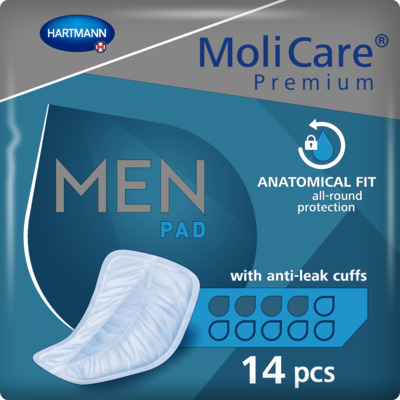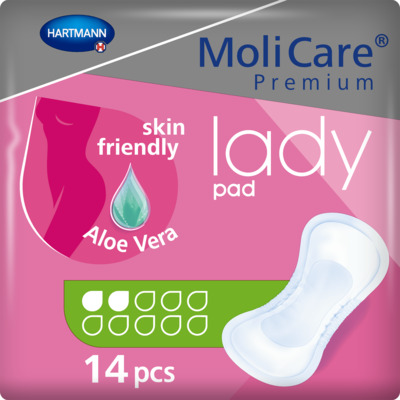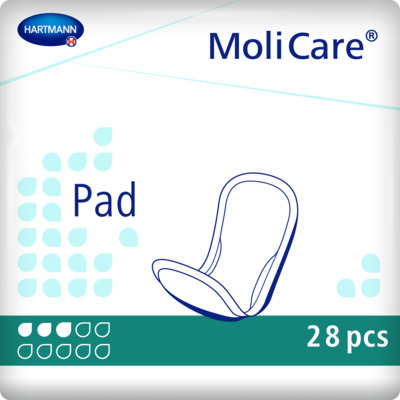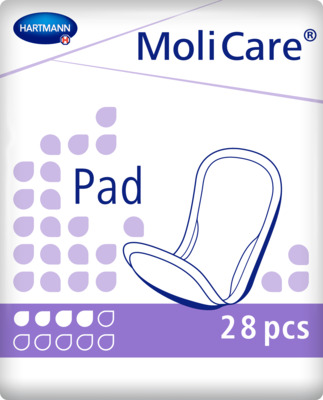Incontinence Advice
Chronic Urinary Retention: Tips for Easing The Condition
Struggling to completely empty your bladder? This could be a sign of chronic urinary retention. Find out what this is, alongside its symptoms and treatment in this in-depth article.

Chronic urinary retention, an often misunderstood condition, refers to the inability to empty the bladder completely. In this article, we will explore what chronic urinary retention is, including its symptoms, causes and treatments. We will also explore the factors that can cause urinary retention. Fortunately, there are numerous treatments available to ensure your comfort is restored.
Key facts about urinary retention
It is also known as bladder retention.
Chronic urinary retention means the bladder is not fully emptied of urine after going to the toilet.
Urinary retention can occur suddenly (acute urinary retention) or develop over a longer period of time (chronic urinary retention).
Chronic urinary retention is not typically a medical emergency, as most urine is still draining out, so your doctor will usually refer you to a specialist for some tests to determine the underlying cause.
What is chronic urinary retention?
Recognising and addressing urine retention starts with understanding what it is.
Urinary retention is when the bladder does not fully empty, leading to complications and discomfort. This condition can stem from a variety of causes, from physical blockages and weak bladder muscles to neurological disorders that affect the bladder's normal function.
Residual urine
Residual urine refers to the urine that remains in the bladder after urination. Normally, the bladder empties completely when you urinate, but in cases of chronic urinary retention, some urine is left behind. This retention can increase the risk of urinary tract infections (UTIs), as bacteria now have a favourable environment to grow in. It’s crucial for those experiencing symptoms to seek medical assessment to prevent further complications.
If your bladder is performing abnormally, and you are concerned about leakages, protect yourself with our range of incontinence products. Order today.
Newsletter subscription - HARTMANN Direct
Causes of urinary retention
Urinary retention can happen for several reasons. These causes can include:
Obstruction: When there's a physical barrier, such as an enlarged prostate or urethral stricture, it prevents the flow of urine out of the bladder. This is particularly common in men due to conditions like benign prostatic enlargement (BPH).
Constipation: Constipation can lead to urinary retention by compressing the bladder and urethra, which obstructs the flow of urine. This pressure from accumulated stool restricts the bladder’s ability to expand fully, resulting in urinary retention, a decreased urine stream, and incomplete bladder emptying.
Weak bladder or pelvic floor muscles: Over time, the muscles responsible for bladder contraction can weaken, making them unable to empty the bladder fully.
Neurological conditions: Conditions such as diabetes, Parkinson’s disease and multiple sclerosis can provoke this issue by impairing nerve signals necessary for bladder control.
Medication: Some medication can lead to urinary retention. Discuss with your doctor or pharmacist if your symptoms occurred after starting some new medication.
Additional factors might include behavioural causes like voiding dysfunction, where individuals delay urination due to anxiety or a lack of access to suitable facilities, further complicating the condition.
Fowler’s syndrome
Fowler’s syndrome is another notable cause of urinary retention, predominantly affecting young women. This condition involves the urethral sphincter failing to relax correctly, which inhibits the normal passage of urine. While not linked to a neurological disorder, Fowler’s syndrome frequently coincides with other conditions such as polycystic ovary syndrome, complicating diagnosis and treatment.

Symptoms of chronic urinary retention
Identifying the symptoms of urine retention is crucial for early detection and management. There may not always be clear symptoms, but here are some common indicators:
Incontinence: Leaking some urine in-between going to the toilet.
Hesitancy: This involves straining to start urination.
Urgency and frequency: Despite the urgent and frequent need to urinate, only a small amount may be expelled.
Abdominal discomfort: There's often a sensation that the bladder isn’t fully emptied after going to the toilet.
Frequent urinary tract infections (UTIs): UTIs can develop due to residual urine remaining in the bladder.
Nocturia: Waking up frequently during the night to urinate.
These symptoms require attention from a healthcare professional, as, if left untreated, kidney damage can occur if urine is not able to drain out of the urinary system properly. Having a Just Can’t Wait toilet card can aid you when you need to access a public toilet in a hurry.

Diagnosing chronic urinary retention
To diagnose this condition, healthcare professionals may recommend several tests:
Urinalysis: A dipstick test to check for signs of infection and other underlying conditions.
Bladder scan: An ultrasound scan to see and measure the volume of urine left behind in the bladder after passing urine.
Uroflowmetry: Measures the speed and volume of urine flow.
Urodynamics: Assesses how well the bladder, sphincters and urethra are storing and releasing urine.
Cystoscopy: A tiny camera inserted inside the urethra and bladder.
Performing each of these tests will help healthcare professionals diagnose the root cause of the problem.
Treatment
Treatment depends on the underlying cause but typically includes:
Catheterisation: For immediate relief, especially in acute urinary retention, catheters may be used to drain the bladder.
Intermittent self-catheterisation (ISC): This is a technique where patients can insert a single-use, sterile catheter into the bladder themselves to manage urine flow.
Medication: Drugs may be prescribed to improve bladder emptying. Antibiotics may be used if the retention was caused by swelling due to an infection in the urinary system.
Surgery: In cases where physical blockages are present, surgical interventions may be needed.

Gender and age differences in urinary retention
Urinary retention affects men and women in different ways due to distinct anatomical and physiological factors.

Urinary retention in men
For men, bladder retention is frequently linked to prostate problems. An enlarged prostate can obstruct the urethra, the tube through which urine exits the body, causing urinary retention. This condition is a result of the prostate's growth as men age, leading to difficulty in bladder emptying and often needing medical interventions such as medication or surgery.
Whether bladder retention is caused by incontinence or prostate problems, using our male incontinence products can help men of all age groups to handle the conditions with ease.
Urinary retention in women
In women, urinary retention can often be traced back to pelvic floor disorders, such as a prolapsed bladder (cystocele). This occurs when weakened, stretched, or damaged pelvic tissues allow the bladder to drop into the vagina, which can obstruct urine flow.
Additionally, during childbirth, temporary urinary retention can occur, prompting healthcare providers to monitor and manage bladder emptying closely. In the postpartum period, exercises that strengthen the pelvic floor muscles can help those experiencing these issues.
Discover the comfort and confidence of wearing female incontinence products.
Urinary retention in the elderly
Older adults, both male and female, are more likely to suffer from urinary retention due to weakened bladder muscles, and small amounts of residual urine (50–100ml) are frequently found in elderly people.
Furthermore, conditions like bladder or kidney stones can exacerbate urinary challenges by blocking the urine flow, often indicated by pain and quickly identified through diagnostic testing.
For those who care for the elderly, understanding how to manage incontinence in the elderly can help with urinary retention too.
Long-term management is essential to prevent complications like urinary tract infections or kidney damage. Here are some strategies:
Bladder diary: Keeping track of urination patterns can help healthcare providers better understand and treat urinary retention.
Regular check-ups: Frequent medical evaluations ensure that treatment remains effective and adjusts to any changes in condition.
Pelvic floor exercises: Kegel exercises and physiotherapy can help to strengthen the pelvic floor muscles.
Lifestyle adjustments: Certain activities and dietary changes can improve bladder health and reduce symptoms.
Preventing the bladder retaining urine
Chronic urinary retention is a manageable condition with the right medical intervention and self-care strategies. Understanding what it is and recognising its symptoms are the first steps towards effective management. Whether through lifestyle changes, medication, or surgery, you can improve your quality of life significantly. Always consult with a healthcare professional and follow the recommended treatment tailored to your specific needs.
Further reading:
Should you want to know more about the wider correlation between urinary retention and incontinence as a whole, check out our articles on our blog for more insights:
Discover the link between Parkinsons and incontinence for those that suffer from Parkinson’s Disease.
Uncover the correlation between diabetes and incontinence and help combat the condition alongside type 1 and type 2.
Sometimes, the colour of your urine can affect the frequency and experience of a toilet visit. Our guide on urine colour types breaks down what each colour represents.
FAQs
What does urinary retention feel like?
Urinary retention typically feels like the inability to completely empty the bladder, despite having an urge to urinate. It may be accompanied by discomfort or pain in the lower abdomen, a frequent need to urinate, or a weak or intermittent stream when urinating.
Does drinking more water help urinary retention?
Drinking more water can sometimes help with urinary retention by promoting regular bladder function and urine flow. However, it is important to consult with a healthcare provider as excessive fluid intake in the presence of urinary retention might worsen symptoms or lead to discomfort.
What treatment is available for urinary retention?
Treatment for urinary retention often involves catheterisation to relieve the immediate discomfort of a full bladder (in acute urinary retention). Long-term treatment depends on the underlying cause and may include medications to reduce bladder outlet resistance, surgery to correct obstructions, or physical therapy to strengthen pelvic muscles. In some cases, behavioural therapies like bladder training are also recommended.
Sources
NHS. (2009) Benign prostate enlargement: Overview. [online] Available at: https://www.nhs.uk/conditions/prostate-enlargement/ [accessed 03/07/2024]
Bladder and Bowel. (2017) Fowler’s Syndrome. [online] Available at: https://www.bladderandbowel.org/bladder/bladder-conditions-and-symptoms/fowlers-syndrome/ [accessed 03/07/2024]
Watson, S., (2023) Polycystic Ovary Syndrome (PCOS): Symptoms, Causes, and Treatment. Healthline. [online] Available at: https://www.healthline.com/health/polycystic-ovary-disease [accessed 03/07/2024]
Bladder and Bowel Community. (n.d.) FREE Just Can’t Wait Toilet Card. [online] Available at: https://www.bladderandbowel.org/help-information/just-cant-wait-card/ [accessed 03/07/2024]
WebMD Editorial Contributors. (2022) Prolapsed Bladder. Web MD. [online] Available at: https://www.webmd.com/women/prolapsed-bladder [accessed 03/07/2024]

MoliCare® Premium Men Pad 4 Drops
<h2>Comfortable and absorbent</h2> <p>Why MoliCare for men? Hers are some of the key features of the MoliCare® Premium Men Pads from Hartmann:</p> <ul> <li>Discreet and comfortable</li> <li>Fits the male physique</li> <li>3-layer absorbent core</li> <li>Fast-absorbing system</li> <li>Anti-leakage cuffs</li> <li>Odour neutralisers</li> <li>Wide adhesive strip</li> <li>Skin-friendly</li> </ul> <p>With an affordable price and great quality guarantee, you cannot regret choosing MoliCare® Premium Men Pad 4 drops, equipped with anti-leak cuffs, and 14 pieces per bag.</p> <h2>Slim and discreet under clothing</h2> <p>MoliCare® Premium MEN Pads offer reliable support for men dealing with bladder weakness. Whether it's stress incontinence or urge incontinence, these pads for men are designed to provide a discreet and quick solution on the go. Simply place the pad before applying your underwear and secure it with the adhesive strip for worry-free protection. MoliCare® Premium MEN Pads offer full coverage for men facing very light to moderate bladder weakness.</p> <h2>Leakage protection for men</h2> <p>MoliCare® understands that each individual's incontinence needs are unique. That's why our incontinence products, including MoliCare® Premium MEN Pads, are available in different absorbency levels. You can find the perfect fit and protection for your specific requirements.</p> <h2>Reliable and soft on the skin</h2> <p>Our body-shaped absorbent pads are designed to deliver dependable and skin-friendly incontinence protection every day. Experience discreet comfort with the soft, cotton-like materials and the added benefit of an odour neutraliser, ensuring you feel fresh and confident throughout the day.</p> <h2>Fast delivery to your home</h2> <p>At HARTMANN Direct, we ensure a fast delivery service for all our products. Enjoy free delivery on orders over £50, making it convenient and hassle-free to receive the incontinence products you need. Our dedicated customer care team is here to discuss your incontinence product needs and answer any questions you may have. Call us today on 0800 028 9470 to experience the comfort and confidence that MoliCare® Premium MEN Pads can provide.</p>
MoliCare® Premium Lady Pad 2 Drops
<h2>Skin Friendly Pant Liners</h2> <p>For women that experience slight incontinence and bladder weakness, across different age groups, it can be a challenge to find the right bladder weakness product that is easy to apply and wear without the worry of potential leakages. Fortunately, we understand this approach, hence why we are happy to offer our MoliCare® Premium Lady Pad 2 drops, that is skin-friendly, Aloe Vera applied, and comes with 14 liners per bag.</p> <h2>Slim and discreet liners</h2> <p>Whether dealing with stress incontinence or urge incontinence, these panty liners offer a discreet and easy solution on the go. Simply place the pad in your underwear and secure it with the adhesive strip for all-round protection. Available in different absorbency levels, MoliCare® bladder weakness products cater to all levels of bladder weakness, ensuring secure care.</p> <h2>Control Bladder Weakness</h2> <p>Enjoy the benefits of these body-shaped absorbent panty liners, designed for women with bladder weakness. The pads offer discreet, reliable protection with features including odour control and fast absorption.</p> <p>With a wide adhesive strip, you can comfortably fix the pad in your regular underwear, providing secure and comfortable fixation. The pads are skin-friendly, featuring soft, breathable materials, including foam cuffs, and a top sheet treated with Aloe Vera.</p> <p>Keeping your skin healthy is a priority, which is why MoliCare® Premium Lady Pads have a skin-neutral pH value of 5.5 and an antibacterial finish. They are also dermatologically tested, offering peace of mind.</p> <h2>Buy pant liners online</h2> <p>Never worry about running out with our convenient order service and fast delivery direct to your door. Enjoy free shipping on orders over £50.</p> <p>If you need assistance, our professional customer service team is here to support you in choosing the right product. Reach out to us today at 0800 028 9470 and experience the comfort and reliability of MoliCare® Premium Lady Pads.</p>
MoliCare® Pad 3 Drops
<h2>Incontinence pads for men and women</h2> <p>Protect yourself against slight bladder weakness with the MoliCare® Pad 3 drops. Suitable for men and women, offering an ideal solution to regain control and live your active life without interruptions. Slimline, discreet, and contoured to fit your body, these incontinence pads ensure a comfortable and barely noticeable feel, providing exceptional dryness and protection for slight incontinence.</p> <p>Crafted with soft, skin-friendly fabric and a polyester backsheet, these incontinence pads ensure you can confidently go about your day, secure against minor leaks. The wide adhesive fixing strip keeps the pad securely in place, while the super absorbent core wicks moisture away from your skin. The elastic anti-leak edging adds an extra layer of reassurance, and odour neutraliser keeps you feeling fresh and confident. With the MoliCare® Pad 3 drops, you no longer need to let slight or occasional incontinence hold you back from enjoying life to the fullest. Simply adhere the pad to your underwear, and you will barely feel the difference.</p> <h2>Price match promise</h2> <p>Experience convenience with our fast delivery service, bringing your chosen products directly to your door. At HARTMANN Direct, we offer a price match promise and free delivery for orders over £50, making sure you receive both quality and value.</p> <p>If you need further assistance, our customer care team is here to help. Give us a call today at 0800 028 9470, and we'll find the perfect incontinence product tailored to your needs. Take charge of your life with the reliable and comfortable protection of MoliCare® Pad 3 drops. Say goodbye to worries and hello to an active and confident lifestyle.</p>
